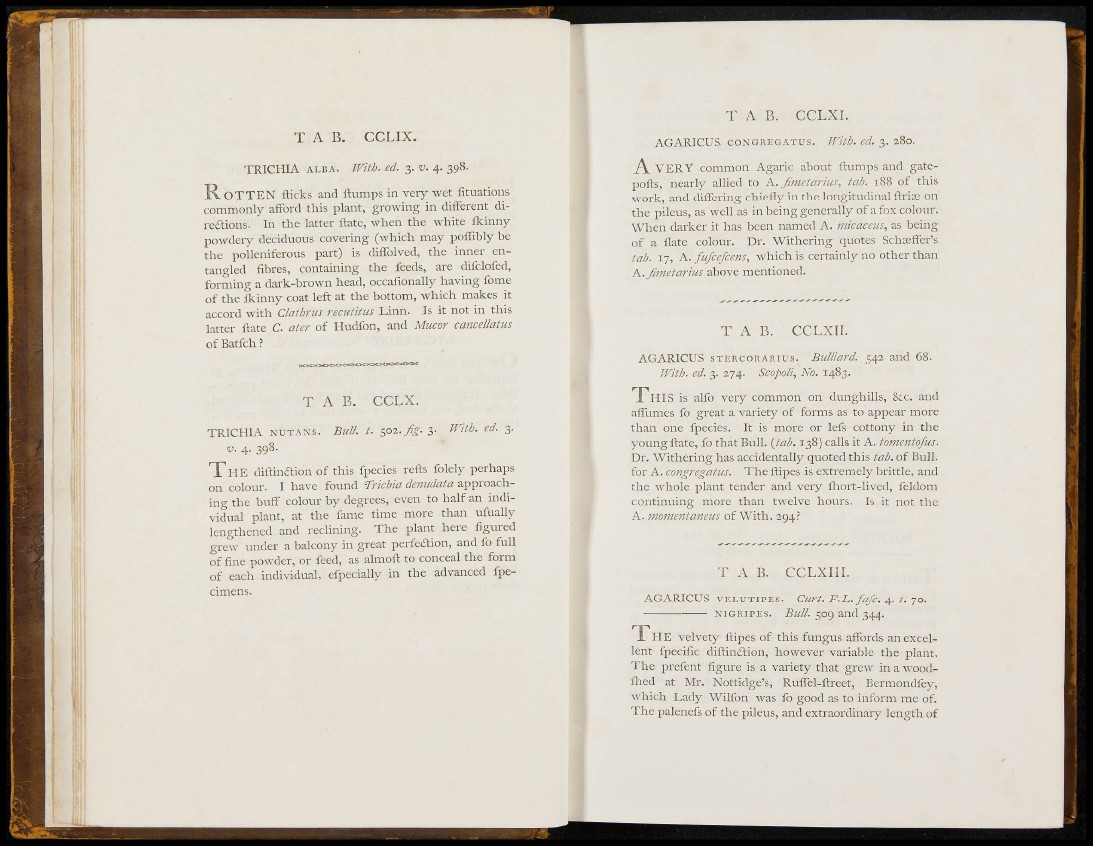
T A B. CCLIX.
TRICHIA ALBA. mth. ed. 3. v. 4. 398.
R OTTEN flicks and flumps in very wet fituations
commonly afford this plant, growing in diiFerent direaions.
In the latter ftate, when the white Ikinny
powdery deciduous covering (which may poflibly be
the poileniferous part) is diffolved, the inner entangled
fibres, containing the feeds, are difclofed,
forming a dark-brown head, occafionally having fome
of the Ikinny coat left at the bottom, which makes it
accord with Clathrus recutitus Linn. Is it not in this
latter ftate C. ater of Hirdfon, and Mucor cancellatus
of Batfch ?
T A B . CCLX.
TRICHIA NUTANS. Bull. t. ^oi-fig- 3- ^'i^b. ed. 3.
V. 4. 398.
T h e diflinftion of this fpecies refls folely perhaps
on colour. I have found Trkbia denudata approaching
the buff colour by degrees, even to half an individual
plant, at the fame time more than ufually
lengthened and reclining. The plant here figured
grew under a balcony in great perfeftion, and fo full
of fine powder, or feed, as almoft to conceal the form
of each individual, efpecially in the advanced fpecimens.
T A B. CCLXÎ.
AGARICUS CONGREGATUS. With. ed. 3 . 280.
A VERY common Agaric about flumps and gatepofls,
nearly allied to K. fimetarius, tab. 188 of this
work, and differing chiefly in the longitudinal ftrioe on
the pileus, as well as in being generally of a fox colour.
When darker it has been named A. mkacetis, as being
of a flate colour. Dr. Withering quotes Schoeffer's
tab. 17, A. fufcejcens, which is certainly no other than
k.Jimetarius above mentioned.
T A B. CCLXII.
AGARICUS STERCORARIUS. BuUiard. 542 and 68.
With. ed. 3. 274. Scopoli, No. 1483.
T H I S is alfo very common on dunghills, &c. and
affumes fo great a variety of forms as to appear more
than one fpecies. It is more or lefs cottony in the
young ftate, fo that Bull. {tab. 138) calls it A. tomentofus.
Dr. Withering has accidentally quoted this tab. of Bull,
for A. congregatus. The ftipes is extremely brittle, and
the whole plant tender and very fliort-lived, feldom
continuing more than twelve hours. Is it not the
A. momentaneus of With. 294.'
T A B. CCLXII I.
AGARICUS VELUTIPES. Curt. F.L. fafc. t.-jo.
N I G R I P E S . Bull. 509 and 344.
T h e velvety ftipes of this fungus affords an excellent
fpecific diflinition, however variable the plant.
The prefent figure is a variety that grew in a woodflied
at Mr. Nottidge's, Ruffel-flreet, Bermondfey,
which Lady Wilfon was fo good as to inform me of.
The palenefs of the pileus, and extraordinary length of
m